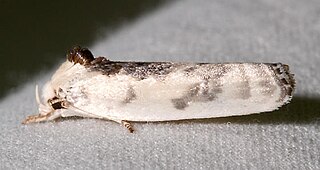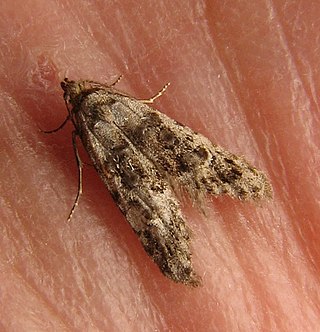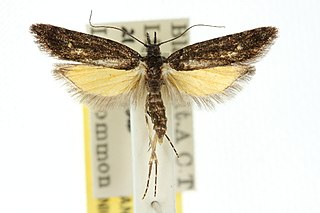
Spilomelinae is a very species-rich subfamily of the lepidopteran family Crambidae, the crambid snout moths. With 4,135 described species in 344 genera worldwide, it is the most speciose group among pyraloids.

Urodidae, whose species are commonly known as false burnet moths, is a family of moths in the lepidopteran order. It is the type genus in the superfamily, Urodoidea, with three genera, one of which, Wockia, occurs in Europe.

The Plutellidae are a family of moths commonly known as the diamondback moths, named after the diamondback moth of European origin. It was once considered to have three subfamilies: Plutellinae, Praydinae, and Scythropiinae. Praydinae was later elevated to its own family, Praydidae, while Scythropiinae has variously been moved to Yponomeutidae or also elevated to its own family.

Hypatima is a genus of the twirler moth family (Gelechiidae). Among these, it belongs to a distinct lineage, which is variously treated as tribe Chelariini in subfamilies Dichomeridinae, Gelechiinae, or even Pexicopiinae, and historically was considered a subfamily in its own right, Chelariinae. Of this lineage, Hypatima – under its junior synonym Chelaria – is the type genus. This genus has numerous species, but its exact limits are not quite clear. This genus occurs mainly in the Southern Hemisphere, though one of the better-known species is the only member of this genus native to Europe, the lobster-clawed moth.

Udea is a genus of snout moths in the subfamily Spilomelinae of the family Crambidae. The genus was erected by Achille Guenée in 1845. The currently known 216 species are present on all continents except Antarctica. About 41 species are native to Hawaii.

Antaeotricha is a genus of moths. It is the largest genus in the subfamily Stenomatinae, numbering over 400 species in the Western Hemisphere.

Bondia is a genus of moths in the Carposinidae family.
Commatarcha is a genus of moths in the Carposinidae family.
Bondia attenuatana is a moth in the family Carposinidae. It was described by Edward Meyrick in 1882. It is found in Australia, where it has been recorded from New South Wales.

Bondia dissolutana is a moth in the family Carposinidae. It was described by Edward Meyrick in 1882. It is found in Australia, where it has been recorded from New South Wales.
Bondia maleficana is a moth in the family Carposinidae. It was described by Edward Meyrick in 1882. It is found in Australia, where it has been recorded from Queensland and New South Wales.
Bondia fuscata is a moth in the Carposinidae family. It was described by Davis in 1969. It is found in North America, where it has been recorded from Arizona.

Bondia shastana is a moth in the Carposinidae family. It was described by Donald R. Davis in 1969. It is found in North America, where it has been recorded from Oregon, California and Arizona.

Bondia caseata is a moth in the family Carposinidae. It was described by Edward Meyrick in 1910. It is found in Australia, where it has been recorded from Victoria and South Australia.
Bondia digramma is a moth in the family Carposinidae. It was described by Edward Meyrick in 1910. It is found in Australia, where it has been recorded from Western Australia.

Bondia crescentella, the crescent-marked bondia, is a moth in the Carposinidae family. It was described by Walsingham in 1882. It is found in North America, where it has been recorded in southern Canada, from British Columbia to Nova Scotia. In the United States, it is found from Minnesota south to Arkansas and east to Virginia.

Bondia comonana, the prune limb borer, is a moth in the Carposinidae family. It was described by William D. Kearfott in 1907. It is found in North America, where it has been recorded from Washington to Colorado, Arizona and California and across southern Canada to Maine.












